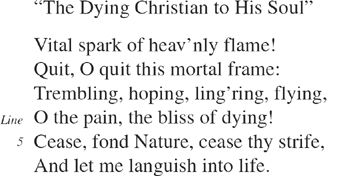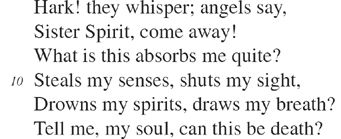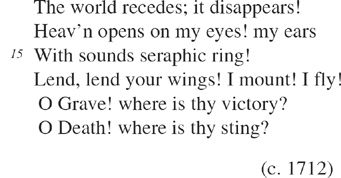| Question | Correct Answer | Your Answer | Result | Explanation |
| 1 | E | 0 | 0 | The author employs all of these techniques, but nowhere makes any Dickensian allusion (E). There is expressive use of punctuation marks, especially exclamation points, throughout (A). The rhyme scheme is regular: AA, BB, CC, DD, EE, FF, etc. (B), and each of the lines has the same number of syllables (7), making the meter regular (C). There are many adjectives: “fond,” “seraphic,” etc. (D). |
| 2 | C | 0 | 0 | The narrator is mocking death by saying that he’s heard so much about its sting and questioning where it is (C). The question is not harsh (A). The question is not curious or doubtful (B). The question is not earnest—the narrator is not really looking for death’s sting (D). There is no paradox in the question (E). |
| 3 | D | 0 | 0 | “Sounds,” in this case, is a noun, not a verb (D). All of the other answers are active verbs (A), (B), (C), and (E). |
| 4 | A | 0 | 0 | In the first stanza the narrator talks to nature; in the second, he talks to his soul, and in the third, he asks the angels to lend him their wings (A). He does not talk about life after death (although he can see heaven, he does not talk about what life will be like there) (B). The first stanza says that death is blissful as well as painful (C). The speaker is the same throughout the poem (D). The second stanza does not taunt death, and the third stanza is not reluctant (E). |
| 5 | E | 0 | 0 | The speaker is asking death to take him from his body (E). “Frame” is not a picture of the world (A) or any previously held image (B). The speaker does not talk about the frame as metaphor (C), but rather the literal frame of the body (D). |
| 6 | A | 0 | 0 | Death may be painful (loss of sense, etc.) but it is blissful, too (A). Death has no victory (“where is thy victory?”) (B). He does not talk of resisting death (C). There is no notion that the next life will be better (D). There is no talk of the eternity of death (E). |
| 7 | D | 0 | 0 | The descriptions of death’s symptoms and how death affects his body are elaborate (D). Romance is not a theme in the poem (A). The poem is not playful (B), nor is it harshly critical (C). The poem is emotionally expressive, not cryptic (hard to understand) (E). |
| 8 | B | 0 | 0 | The last lines underscore that death is less about physical pain and more about mental bliss (B). Death does hurt (A). There is no battle being fought (C). The speaker does not have an antagonistic relationship with death (D). Death is not transient (E). |
SAT Literature Practice Test 6
Directions: This test consists of selections from literary works and questions on their content, form, and style. After each passage or poem, choose the best answer to each question.
Now try the techniques out on this next poem. Instead of writing down answers to questions, think about alliteration, rhythm, personification, theme, etc., while you’re reading. Don’t forget to do specific questions first.
FYI, the poem is by Alexander Pope, who lived from 1688-1744.
1. The author of the poem uses all of the following EXCEPT
A. expressive punctuation
B. a particular rhyme scheme
C. regular meter
D. adjectives
E. Dickensian allusion
2. The question “O Death! where is thy sting?” can best be described as
A. harshly rhetorical
B. dubiously questioning
C. gently taunting
D. gravely earnest
E. paradoxical
3. Which of the following is NOT an active verb?
A. Quit (line 2)
B. Draws (line 11)
C. Tell (line 12)
D. Sounds (line 15)
E. Ring (line 15)
4. The three stanzas differ in that
A. the first is directed at nature, the second at the soul, and the third at angels
B. the first speaks of dying, the second speaks of the loss of sense, and the third speaks of life after death
C. the first stanza describes death as purely painful, the second describes the loss of sense, and the third describes angels
D. the speaker of the first stanza is mortal, the speaker of the second is angelic, and the speaker of the third is death
E. the first stanza welcomes death, the second stanza taunts it, and the third stanza reluctantly accepts it
5. By “frame” (line 2), the author most likely means
A. a picture of the world
B. a previously held image of death
C. a cage for the soul
D. a metaphorical skeleton
E. the mortal body
6. The overall theme of the poem is best stated as
A. death is sublime even though it is painful
B. death is the victory of heaven over the soul
C. death can be resisted but it always eventually wins
D. even if one suffers in this life, the next life will be better
E. pain is only temporary; death is eternal
7. The style of the poem can best be described as
A. ornately romantic
B. playfully suggestive
C. harshly critical
D. elaborately descriptive
E. emotionally cryptic
8. The questions in the last two lines serve mainly to emphasize
A. the speaker’s surprise at how little death hurts
B. the mental ecstasy of death overshadowing physical pain
C. the battle that is fought between the body and the soul
D. the speaker’s antagonistic relationship with death
E. the transient nature of death




